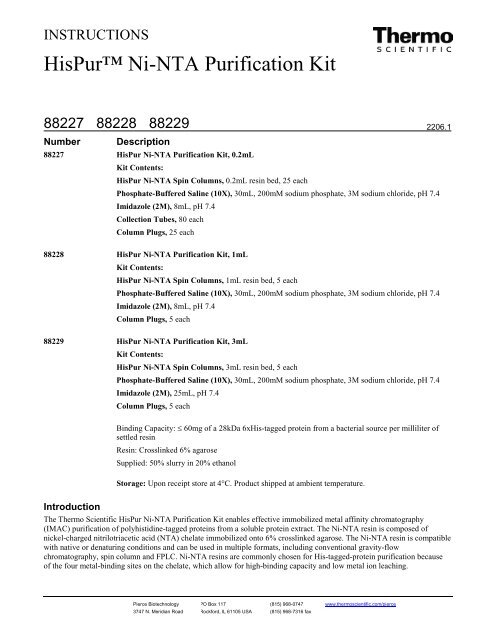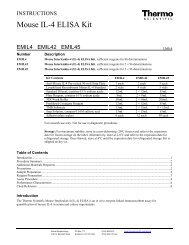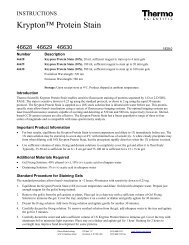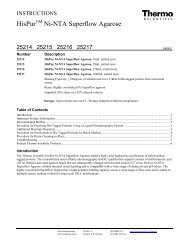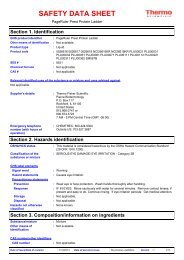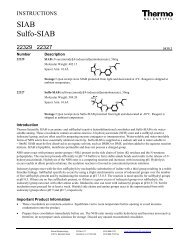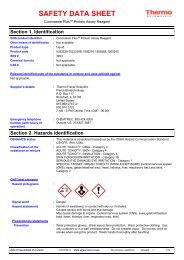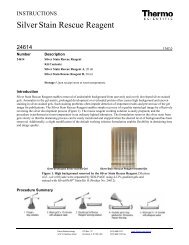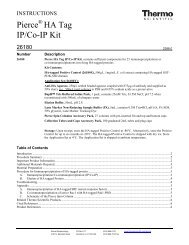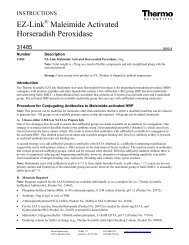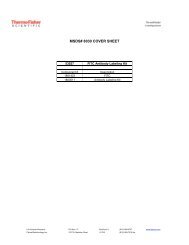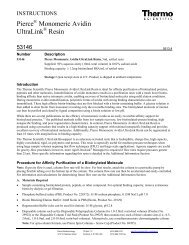HisPur⢠Ni-NTA Purification Kit - Pierce
HisPur⢠Ni-NTA Purification Kit - Pierce
HisPur⢠Ni-NTA Purification Kit - Pierce
Create successful ePaper yourself
Turn your PDF publications into a flip-book with our unique Google optimized e-Paper software.
INSTRUCTIONS<br />
HisPur <strong>Ni</strong>-<strong>NTA</strong> <strong>Purification</strong> <strong>Kit</strong><br />
88227 88228 88229<br />
Number Description<br />
88227 HisPur <strong>Ni</strong>-<strong>NTA</strong> <strong>Purification</strong> <strong>Kit</strong>, 0.2mL<br />
<strong>Kit</strong> Contents:<br />
HisPur <strong>Ni</strong>-<strong>NTA</strong> Spin Columns, 0.2mL resin bed, 25 each<br />
Phosphate-Buffered Saline (10X), 30mL, 200mM sodium phosphate, 3M sodium chloride, pH 7.4<br />
Imidazole (2M), 8mL, pH 7.4<br />
Collection Tubes, 80 each<br />
Column Plugs, 25 each<br />
2206.1<br />
88228 HisPur <strong>Ni</strong>-<strong>NTA</strong> <strong>Purification</strong> <strong>Kit</strong>, 1mL<br />
<strong>Kit</strong> Contents:<br />
HisPur <strong>Ni</strong>-<strong>NTA</strong> Spin Columns, 1mL resin bed, 5 each<br />
Phosphate-Buffered Saline (10X), 30mL, 200mM sodium phosphate, 3M sodium chloride, pH 7.4<br />
Imidazole (2M), 8mL, pH 7.4<br />
Column Plugs, 5 each<br />
88229 HisPur <strong>Ni</strong>-<strong>NTA</strong> <strong>Purification</strong> <strong>Kit</strong>, 3mL<br />
<strong>Kit</strong> Contents:<br />
HisPur <strong>Ni</strong>-<strong>NTA</strong> Spin Columns, 3mL resin bed, 5 each<br />
Phosphate-Buffered Saline (10X), 30mL, 200mM sodium phosphate, 3M sodium chloride, pH 7.4<br />
Imidazole (2M), 25mL, pH 7.4<br />
Column Plugs, 5 each<br />
Binding Capacity: ≤ 60mg of a 28kDa 6xHis-tagged protein from a bacterial source per milliliter of<br />
settled resin<br />
Resin: Crosslinked 6% agarose<br />
Supplied: 50% slurry in 20% ethanol<br />
Storage: Upon receipt store at 4°C. Product shipped at ambient temperature.<br />
Introduction<br />
The Thermo Scientific HisPur <strong>Ni</strong>-<strong>NTA</strong> <strong>Purification</strong> <strong>Kit</strong> enables effective immobilized metal affinity chromatography<br />
(IMAC) purification of polyhistidine-tagged proteins from a soluble protein extract. The <strong>Ni</strong>-<strong>NTA</strong> resin is composed of<br />
nickel-charged nitrilotriacetic acid (<strong>NTA</strong>) chelate immobilized onto 6% crosslinked agarose. The <strong>Ni</strong>-<strong>NTA</strong> resin is compatible<br />
with native or denaturing conditions and can be used in multiple formats, including conventional gravity-flow<br />
chromatography, spin column and FPLC. <strong>Ni</strong>-<strong>NTA</strong> resins are commonly chosen for His-tagged-protein purification because<br />
of the four metal-binding sites on the chelate, which allow for high-binding capacity and low metal ion leaching.<br />
<strong>Pierce</strong> Biotechnology PO Box 117 (815) 968-0747 www.thermoscientific.com/pierce<br />
3747 N. Meridian Road Rockford, lL 61105 USA (815) 968-7316 fax
Important Product Information<br />
• Protein yield and purity are dependent upon the expression level, conformation and solubility characteristics of the<br />
recombinant fusion protein. Therefore, it is important to optimize these parameters before attempting a large-scale<br />
purification. For best results, perform a small-scale test to estimate the expression level and determine the solubility of<br />
each His-tagged protein.<br />
• Optimization of the lysis procedure is critical for maximizing protein yield. Some methods for protein extraction include<br />
using commercially available detergent-based reagents, such as Thermo Scientific B-PER Bacterial Protein Extraction<br />
Reagent with Enzymes (Product No. 90078), and mechanical methods, such as freeze/thaw cycles, sonication or French<br />
press. Add EDTA-free protease inhibitors, such as Thermo Scientific Halt Protease and Phosphatase Inhibitor Cocktail,<br />
EDTA-free (Product No. 78441), to protect proteins from degradation.<br />
• Avoid using protease inhibitors or other additives that contain chelators, such as EDTA, or strong reducing agents, such<br />
as DTT or β-mercaptoethanol, which will disrupt the function of the nickel resin.<br />
• When using the Thermo Scientific Coomassie Plus (Bradford) Assay (Product No. 23238) or Thermo Scientific <strong>Pierce</strong><br />
660 nm Protein Assay (Product No. 22660) to monitor protein concentration in the elution fractions, dilute the samples at<br />
least 1:2 before performing the protein assay.<br />
Additional Materials Required<br />
• Regeneration MES Buffer: 20mM 2-(N-morpholine)-ethanesulfonic acid, 0.1M sodium chloride; pH 5.0<br />
Material Preparation<br />
Depending on the specific protein, buffers might require some optimization. Use the table below to make buffers with<br />
different imidazole concentrations. Adjust the total volume depending on the resin volume used. For most proteins, the<br />
following imidazole concentrations are recommended:<br />
• Equilibration Buffer: 10mM imidazole<br />
• Wash Buffer: 25mM imidazole<br />
• Elution Buffer: 250mM imidazole<br />
Imidazole Final<br />
Conc. (mM)<br />
10X PBS*<br />
(mL)<br />
2M Imidazole<br />
(μL)<br />
Water<br />
(mL)<br />
10 1 50 8.95<br />
25 1 125 8.875<br />
40 1 200 8.8<br />
60 1 300 8.7<br />
75 1 375 8.625<br />
150 1 750 8.25<br />
200 1 1,000 8<br />
250 1 1,250 7.75<br />
500 1 2,500 6.5<br />
*Phosphate-buffered saline.<br />
Procedure for Spin <strong>Purification</strong> of His-Tagged Proteins<br />
Note: The total volume of the 0.2, 1 and 3mL columns are 1, 8 and 22mL, respectively. If a sample volume is greater than<br />
the column, perform multiple applications and centrifugations until the entire sample has been processed. Be careful not to<br />
exceed the resin’s binding capacity. The HisPur <strong>Ni</strong>-<strong>NTA</strong> Spin Columns also may be used for gravity-flow purifications.<br />
1. Equilibrate column(s) to working temperature. Perform purifications at room temperature or at 4°C.<br />
2. Prepare sample by mixing protein extract with Equilibration Buffer so the total volume equals two resin-bed volumes.<br />
3. Remove the bottom tab from the HisPur <strong>Ni</strong>-<strong>NTA</strong> Spin Column by gently twisting. Place column into a centrifuge tube.<br />
Note: Use 1.5, 15 or 50mL centrifuge tubes for the 0.2, 1 and 3mL spin columns, respectively.<br />
4. Centrifuge column at 700 × g for 2 minutes to remove storage buffer.<br />
<strong>Pierce</strong> Biotechnology PO Box 117 (815) 968-0747 www.thermoscientific.com/pierce<br />
3747 N. Meridian Road Rockford, lL 61105 USA (815) 968-7316 fax<br />
2
5. Equilibrate column with two resin-bed volumes of Equilibration Buffer. Allow buffer to enter the resin bed.<br />
6. Centrifuge column at 700 × g for 2 minutes to remove buffer.<br />
7. Add the prepared protein extract to the column and allow it to enter the resin bed.<br />
Note: For maximal binding, the sample can be incubated for 30 minutes at room temperature or 4°C on an end-over-end<br />
rocking platform.<br />
8. Centrifuge column at 700 × g for 2 minutes and collect the flow-through in a centrifuge tube.<br />
9. Wash resin with two resin-bed volumes of Wash Buffer. Centrifuge at 700 × g for 2 minutes and collect fraction in a<br />
centrifuge tube. Repeat this step two more times collecting each fraction in a separate centrifuge tube.<br />
Note: If desired, perform additional washes. Monitor washes by measuring their absorbance at 280nm.<br />
10. Elute His-tagged proteins from the resin by adding one resin-bed volume of Elution Buffer. Centrifuge at 700 × g for<br />
2 minutes. Repeat this step two more times, collecting each fraction in a separate tube.<br />
Note: If performing gravity-flow add two resin-bed volumes of Elution Buffer to achieve proper flow characteristics.<br />
11. Monitor protein elution by measuring the absorbance of the fractions at 280nm or by Coomassie Plus (Bradford) Assay<br />
Reagent (Product No. 23238). The eluted protein can be directly analyzed by SDS-PAGE.<br />
Note: To remove imidazole for downstream applications, use gel filtration (e.g., Thermo Scientific Zeba Spin Desalting<br />
Columns) or dialysis (e.g., Thermo Scientific Slide-A-Lyzer Dialysis Cassettes).<br />
Procedure for <strong>Ni</strong>-<strong>NTA</strong> Resin Regeneration<br />
The <strong>Ni</strong>-<strong>NTA</strong> resin may be used at least five times without affecting protein yield or purity. Between each use, perform the<br />
procedure as described below to remove residual imidazole and any nonspecifically adsorbed protein. To prevent crosscontamination<br />
of samples, designate a given column to one specific fusion protein.<br />
1. Wash resin with 10 resin-bed volumes of MES Buffer.<br />
2. Wash resin with 10 resin-bed volumes of ultrapure water.<br />
3. Store resin as a 50% slurry in 20% ethanol.<br />
Troubleshooting<br />
Problem Possible Cause Solution<br />
Low protein yield Poor expression of soluble protein Optimize expression conditions<br />
His-tagged protein forms inclusion<br />
bodies<br />
Insufficient cell lysis and extraction<br />
His tag is absent<br />
His tag is inaccessible using native<br />
conditions<br />
His-tagged protein has a low<br />
affinity to the column<br />
Alter growth conditions to minimize inclusion body<br />
formation and maximize soluble protein yield<br />
Solubilize inclusion bodies and perform the purification<br />
with a compatible denaturant (e.g., Thermo Scientific<br />
Inclusion Body Solubilization Reagent, Product No. 78115)<br />
Optimize cell lysis protocol<br />
Verify the sequence or perform an ELISA or Western blot<br />
using an antibody against the His tag<br />
See the Additional Information Section for denaturing<br />
conditions<br />
Optimize the Equilibration or Wash buffer by decreasing<br />
the concentration of imidazole (see Table in the Material<br />
Preparation Section)<br />
Poor protein purity Insufficient column washing Wash column additional times or modify the imidazole<br />
concentration (see Table in Material Preparation Section)<br />
Slow column flow Column is overloaded Apply less protein extract to the column and make sure the<br />
extract is not too viscous or contaminated with cell debris<br />
<strong>Pierce</strong> Biotechnology PO Box 117 (815) 968-0747 www.thermoscientific.com/pierce<br />
3747 N. Meridian Road Rockford, lL 61105 USA (815) 968-7316 fax<br />
3
Additional Information<br />
A. Fusion Proteins Expressed in Inclusion Bodies<br />
Over-expressed proteins are sometimes sequestered in inclusion bodies. Inclusion bodies can be solubilized in 8M urea,<br />
6M guanidine or the Inclusion Body Solubilization Reagent (Product No. 78115); however, a denaturant must be added to the<br />
buffers to ensure the protein remains soluble throughout the procedure. (Follow the spin purification procedure.)<br />
If using 8 M urea, you may proceed directly to SDS-PAGE without sample clean-up. If using 6 M guanidine, perform one of<br />
the following steps before SDS-PAGE: 1) Dilute sample 1:6 in ultrapure water; 2) Perform buffer exchange with dialysis or<br />
desalting; 3) Perform TCA precipitation; 4) Use the Thermo Scientific <strong>Pierce</strong> SDS-PAGE Sample Prep <strong>Kit</strong> (Product No.<br />
89888).<br />
For denaturing conditions prepare the following buffers:<br />
• Equilibration Buffer: PBS with 6M guanidine•HCl, 10mM imidazole; pH 7.4<br />
• Wash Buffer: PBS with 6M guanidine•HCl, 25mM imidazole; pH 7.4<br />
• Elution Buffer: PBS with 6M guanidine•HCl, 250mM imidazole; pH 7.4<br />
B. Visit the website for additional information relating to this product including the following:<br />
• Tech Tip # 43: Protein Stability and Storage<br />
• Tech Tip # 40: Convert Between Times Gravity (× g) and Centrifuge Rotor Speed (RPM)<br />
• Tech Tip # 6: Extinction Coefficients Guide<br />
Related Thermo Scientific Products<br />
88270 <strong>Pierce</strong> ® High Capacity Endotoxin Removal Resin, 10mL<br />
88282 <strong>Pierce</strong> LAL Chromogenic Endotoxin Quantitation <strong>Kit</strong><br />
88221 HisPur <strong>Ni</strong>-<strong>NTA</strong> Resin, 10mL<br />
89967 HisPur Cobalt Spin Columns, 0.2mL, 25 each<br />
89968 HisPur Cobalt Spin Columns, 1mL, 5 each<br />
89969 HisPur Cobalt Spin Columns, 3mL, 5 each<br />
24110 Guanidine•HCl, 500g<br />
90078 B-PER ® Bacterial Protein Extraction Reagent with Enzymes, 250mL<br />
87785 Halt Protease Inhibitor Cocktail (100X), EDTA-free, 1mL<br />
78441 Halt Protease and Phosphatase Inhibitor Cocktail, EDTA-free (100X), 1mL<br />
23238 Coomassie Plus (Bradford) Assay Reagent, 300mL<br />
22660 <strong>Pierce</strong> 660 nm Protein Assay Reagent, 750mL<br />
78115 Inclusion Body Solubilization Reagent, 100mL<br />
89890 Zeba Spin Desalting Columns, 7K MWCO, 2mL, 25 columns, for 200-700μL samples<br />
89892 Zeba Spin Desalting Columns, 7K MWCO, 5mL, 25 columns, for 500-2,000μL samples<br />
89894 Zeba Spin Desalting Columns, 7K MWCO, 10mL, 25 columns, for 1,500-4,000μL samples<br />
87769 Zeba Spin Desalting Columns, 40K MWCO, 2mL, 25 columns, for 200-900μL samples<br />
87771 Zeba Spin Desalting Columns, 40K MWCO, 5mL, 25 columns, for 300-2,000μL samples<br />
87773 Zeba Spin Desalting Columns, 40K MWCO, 10mL, 25 columns, for 1,000-4,000μL samples<br />
87730 Slide-A-Lyzer G2 Dialysis Cassettes, 10K MWCO, 3mL, 10 cassettes<br />
87731 Slide-A-Lyzer G2 Dialysis Cassettes, 10K MWCO, 15mL, 8 cassettes<br />
<strong>Pierce</strong> Biotechnology PO Box 117 (815) 968-0747 www.thermoscientific.com/pierce<br />
3747 N. Meridian Road Rockford, lL 61105 USA (815) 968-7316 fax<br />
4
This product (“Product”) is warranted to operate or perform substantially in conformance with published Product specifications in effect at the time of sale,<br />
as set forth in the Product documentation, specifications and/or accompanying package inserts (“Documentation”) and to be free from defects in material and<br />
workmanship. Unless otherwise expressly authorized in writing, Products are supplied for research use only. No claim of suitability for use in applications<br />
regulated by FDA is made. The warranty provided herein is valid only when used by properly trained individuals. Unless otherwise stated in the<br />
Documentation, this warranty is limited to one year from date of shipment when the Product is subjected to normal, proper and intended usage. This<br />
warranty does not extend to anyone other than the original purchaser of the Product (“Buyer”).<br />
No other warranties, express or implied, are granted, including without limitation, implied warranties of merchantability, fitness for any particular<br />
purpose, or non infringement. Buyer’s exclusive remedy for non-conforming Products during the warranty period is limited to replacement of or<br />
refund for the non-conforming Product(s).<br />
There is no obligation to replace Products as the result of (i) accident, disaster or event of force majeure, (ii) misuse, fault or negligence of or by Buyer, (iii)<br />
use of the Products in a manner for which they were not designed, or (iv) improper storage and handling of the Products.<br />
Current product instructions are available at www.thermoscientific.com/pierce. For a faxed copy, call 800-874-3723 or contact your local distributor.<br />
© 2012 Thermo Fisher Scientific Inc. All rights reserved. Unless otherwise indicated, all trademarks are property of Thermo Fisher Scientific Inc. and its<br />
subsidiaries. Printed in the USA.<br />
<strong>Pierce</strong> Biotechnology PO Box 117 (815) 968-0747 www.thermoscientific.com/pierce<br />
3747 N. Meridian Road Rockford, lL 61105 USA (815) 968-7316 fax<br />
5


